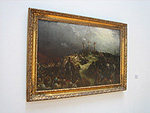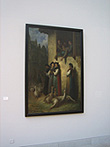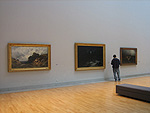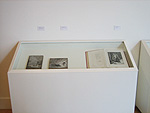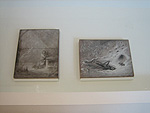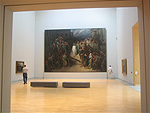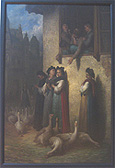The browser will either open the file, download it, or display a dialog.
|
Gustave Doré, oeuvres de la collection du Musée d'Art Moderne et Contemporain de Strasbourg
The exhibition was previously shown at:
Museo de Bellas Artes de Bilbao
Salle d'expositions San Eloy, Caja Duero, Salamanca
Museo de Bellas Artes de Seville |
|||
| When a museum is extremely rich in the holdings of a native son, as is the case with the Musée d'Art Moderne et Contemporain in Strasbourg, France with the works of Gustave Doré, it is useful, even exemplary, when the museum uses the artist's works to advance his reputation by making others aware of the range of his artistic efforts. One way to accomplish this is by developing a traveling exhibition that showcases the artist's work, as well as preparing a publication that presents a detailed, thematic interpretation of the art within a larger, historical context. Once the touring show closes, it can then be installed in the galleries of the originating museum, thereby providing an opportunity to permanently highlight the works of a native son in his hometown. This was exactly the route taken by Strasbourg. Throughout 2004 and early 2005, a major traveling exhibition of Doré's work, drawn from the museum's collection, toured Spain where it was shown in several museums. At the end of the journey, Doré's works were installed in the Strasbourg museum where visitors had the opportunity to examine the phases of his work by following a thematic and historical approach. With the possibility of viewing the show in situ in Strasbourg, in the well-appointed rooms of the museum and with ample explanatory labels, the cumulative impact of the oeuvre became deeply engaging. It revealed the range of Doré's talents, and demonstrated that his work, in all media, are deserving of wider exposure, perhaps through another major exhibition in the United States (figs. 1- 7). | ||||
| One critically important point made by the exhibition was that Doré was an extraordinarily prolific creator whose diversity often went unnoticed in his lifetime. Historically, most attention centered on his drawings and his illustrations for a large number of texts including those created for Milton and the Bible; and while these are the images upon which his reputation often rests, the fact that the Strasbourg collection has 377 individual works, including 18 oil paintings and 4 sculptures, offered an opportune moment to expand the known canon. Visitors enjoyed a rare opportunity to see the whole range of the artist's creative output. | ||||
| How Strasbourg was able to collect so many works by Doré is also a narrative worth examining. Shortly after his death, and following the sale of his studio in 1885, a number of pieces entered this museum through gifts and purchases, thus initiating considerable interest in the preservation of his reputation by inaugurating a central repository for the study of Doré's work. The original collection nucleus was significantly expanded almost a century later, when the objects owned by the American, Samuel Frances Clapp, who had collected works by Doré for over twenty years, were purchased by the museum in 1993. | ||||
|
The exhibition and catalogue make clear that Doré was often enmeshed in social issues, and that a number of his images have to be interpreted against a broader political context. An early album of prints reveals that he was not well disposed toward the despotic Tsarist regime in Russia. Completed at the time of the Crimean War, it shows that Doré opposed autocratic rulers, no matter what their country of origin; the images make Doré's positions amply clear as they reveal the intensity of his early beliefs. Images from this period emphasize Doré the caricaturist. However, from the age of twenty-four, he moved away from social satire to follow a more lucrative, less controversial path, to become the primary illustrator and painter of the best-known literary texts of the era. In 1853, when he learned that there would be a new edition of the works of Rabelais, he asked whether he could illustrate the series and, by 1854, he had executed 104 illustrations for the text. These images generated considerable interest with the public, helping to establish his fame and leading to other commissions. As a leading bibliophile, and scholar of literary texts, Doré also recognized that he had a lucrative field opening before him, a dimension of his work that was amply explored in the exhibition in Strasbourg. He soon set out to illustrate a wide variety of authors: Dante, Virgil, and Shakespeare, never failing to grasp that these texts needed to be studied and illustrated with care in order to visualize the most salient moments. These illustrations introduced him, and his work, to a literary public hungry not only for texts, but also for handsome volumes to grace their libraries. The Strasbourg exhibition gave the public, and Doré specialists, the chance to see book illustrations from throughout the artist's career, thus establishing his position as one of the most talented and prolific illustrators of his era. The fact that the prints were also often shown alongside the books that they illustrated made a valuable didactic display. Even more interesting for the viewer, the block on which a print was originally drawn was also occasionally, and effectively, presented, thus providing a picture of how Doré actually worked, and the meticulous care he brought to his illustrations. |
||||
| What is less known about Doré is that during the artist's greatest period of activity and creativity in the print medium, he devoted an equal amount of time, if not more energy, to the completion of large scale paintings. These works, often religious in theme, revealed a very strong romantic temperament and an ability to create narratives capable of involving the public. Doré‘s later interests in landscapes, which he continued to produce until his death in 1883, were also very well represented in the exhibition. Among the best of the romantic religious works created by Doré, Christ Leaving the Temple or the Calvary, which belongs to the Museum, presents an image of great haunting strength and evocativeness due to size and use of rich colors. Some writers at the time considered the work to be visionary in scope, and exuding a personal symbolism applied to well known and loved scenes. Other paintings, such as Saltimbanques, showed another side of the artist's romantic imagery, suggesting that certain themes could be construed as metaphors both for the problems affecting France and, in general, issues of security and hunger that were devastating the poor in other countries such as England or Spain. The playing cards in the painting, strewn on the ground in front of the forlorn family, suggest that the fate of the poor was often decided by chance. These deeply engaged narrative paintings, exhibited permanently in the artist's lifetime in the Doré Gallery in London, greatly added to his reputation during the mid-century. In effect, he was able to capitalize on his fame as an illustrator in order to show these works publicly. | ||||
| One issue that such a comprehensive show raises is the way in which we must reconsider the contribution of Doré to nineteenth-century creativity. He can no longer be seen simply as an illustrator of great texts. Instead, his paintings and drawings must also be recognized as important to his total creative agenda, establishing his multi-dimensional artistic personality. The fact that so many of Doré's works can be found in one collection demonstrates the wisdom of the curators of the Museum, and of the cultural organization of the city of Strasbourg, in establishing this collection in the first place. As an artist very much of his time, Doré demonstrated that artists could make a living through one medium, artistic and illustrative prints, while, at the same time, exploit other facets of his talent that were just as important as his dedication to illustration. If Doré's paintings are not easily categorized, and represent moments in his life when he was trying to attain a higher echelon in the artistic pantheon than that accorded to illustrators, the fact that these paintings and drawings reveal a true penchant for the visionary adds immeasurably to Doré's reputation, one that has been hidden from view for too long a time and which has begun to emerge through the dedication of his native city. | ||||
| Gabriel P. Weisberg University of Minnesota vooni1942@aol.com |
||||


